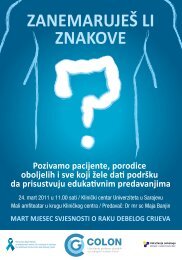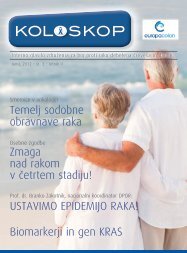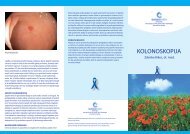SIRTEX Leaflet - English - EuropaColon
SIRTEX Leaflet - English - EuropaColon
SIRTEX Leaflet - English - EuropaColon
You also want an ePaper? Increase the reach of your titles
YUMPU automatically turns print PDFs into web optimized ePapers that Google loves.
Sirtex is committed to the development of innovative therapies for liver cancer in order<br />
to improve patient survival and quality of life.<br />
For more information about Sirtex or to contact us:<br />
Sirtex Medical Limited Sirtex Medical Europe GmbH<br />
Unit F6 Parkview Building Lane Cove Business Park Walter-Flex-Straße 2<br />
16 Mars Road Lane Cove NSW 2066 Australia 53113 Bonn Germany<br />
Tel +612 9936 1400 Fax +612 9936 1404 Tel +49 228 1840 730 Fax +49 228 1840 735<br />
www.sirtex.com<br />
SIR-Spheres® is a registered trademark of Sirtex SIR-Spheres Pty Ltd<br />
107-MAR-LEAF rev. 2 27546/888<br />
A Patient’s Guide<br />
microspheres<br />
Selective Internal Radiation Therapy (SIRT) for<br />
liver tumours using SIR-Spheres ® microspheres<br />
This leaflet is provided as a service by Sirtex Medical Limited (Sirtex), and is intended to provide patients and family<br />
members with an overview of Selective Internal Radiation Therapy using SIR-Spheres microspheres. Specific concerns<br />
related to your medical condition should be addressed by your attending doctor.
INTRODUCTION<br />
microspheres<br />
This leaflet has been developed for patients being offered or considered for Selective Internal<br />
Radiation Therapy (SIRT, also called radioembolisation) using SIR-Spheres microspheres.<br />
It is intended to provide you with information about SIR-Spheres microspheres and the SIRT<br />
procedure, possible side effects, and to answer some of the questions you may have about<br />
this innovative treatment. If you have any further questions about the SIRT procedure, please<br />
speak to your doctor or nurse. Your doctor can address any specific concerns you may have<br />
about your medical condition.<br />
WHAT IS SIRT AND WHAT ARE<br />
SIR-SPHERES MICROSPHERES?<br />
SIRT is a targeted treatment for liver tumours that<br />
delivers millions of tiny radioactive beads called<br />
SIR-Spheres microspheres directly to the liver tumours.<br />
liver cancer), or they may be tumours that have spread to the liver from another part of the<br />
body (also known as secondary liver cancer or metastases).<br />
WHO IS SIRT SUITABLE FOR?<br />
SIRT is only suitable for patients who have liver tumours where either the liver is the only site of<br />
disease or the liver is the major site of disease. SIRT has no effect on tumours outside the liver.<br />
Before SIRT can be offered as a treatment option for patients, there are a number of other<br />
factors that have to be considered. Most importantly, you need to have a sufficiently healthy<br />
liver that is working satisfactorily. This is usually determined by a simple blood test.<br />
The development of SIR-Spheres microspheres started<br />
in Australia in the 1980s, with regulatory approval<br />
being granted in Europe and the United States in 2002.<br />
WHO PERFORMS THE SIRT PROCEDURE?<br />
The SIRT procedure is conducted by a medical team that includes a specialist known as an<br />
interventional radiologist, together with other specialists trained to work with radiation.<br />
Thousands of patients have now been treated at<br />
centres of excellence around the world.<br />
Liver tumours being treated with SIR-Spheres<br />
microspheres<br />
WHAT WILL MY TREATMENT TEAM DO BEFORE ADMINISTERING SIRT?<br />
Your treatment team will want to know about your previous cancer history and any other<br />
SIR-Spheres microspheres are approved for the treatment of liver tumours that cannot be<br />
medical conditions. They will then conduct a number of initial tests to ensure that it is possible<br />
removed by surgery. These may be tumours that start in the liver (also known as primary<br />
for you to receive SIRT safely. Normally patients will undergo two procedures under conscious<br />
1<br />
sedation. Both procedures will include a radiology procedure known as an angiogram.<br />
2
The purpose of the first angiogram or mapping is to prepare your liver for the SIRT treatment.<br />
During the mapping procedure your interventional radiologists will block (embolise) the<br />
vessels to minimise the potential for the microspheres to travel to areas outside your liver (e.g.<br />
the stomach or intestine). You will also receive a small amount of radioactive “test beads” to<br />
check the amount of blood that flows from the liver to the lungs.<br />
Assuming that the results of these initial tests are acceptable, the dose of SIR-Spheres<br />
microspheres will be determined. The SIR-Spheres microspheres will then be administered<br />
during a second procedure which is typically conducted one to two weeks after the initial<br />
tests are completed.<br />
HOW ARE SIR-SPHERES MICROSPHERES<br />
ADMINISTERED?<br />
The interventional radiologist makes a small puncture, usually<br />
into the femoral artery near the groin. A small flexible tube, known<br />
as a catheter, is then guided through the artery into the liver.<br />
The SIR-Spheres microspheres are administered through this<br />
catheter. The whole procedure may take about 90 minutes.<br />
You will be sleepy during the procedure but you will be able<br />
to communicate with your treating doctor and the team.<br />
HOW DO SIR-SPHERES MICROSPHERES WORK? microspheres rospheres<br />
The SIRT procedure enables radiation – which is often used to treat cancer – to be sent<br />
directly into the liver tumours by using the tumour’s blood supply. The normal liver tissue takes<br />
about 90% of its blood supply from the portal vein that flows from the intestine, while liver<br />
tumours receive about 90% of their blood supply from the hepatic artery. SIR-Spheres<br />
microspheres are targeted directly at the liver tumours via the hepatic artery, so exposure<br />
to the remaining healthy liver tissue is minimised.<br />
The majority of microspheres are approximately 32 microns<br />
in diameter, about a third of the width of a human hair. The<br />
microspheres are small enough to flow through the hepatic<br />
arteries, but are too large to pass through the small blood<br />
vessels within the tumour, where they become permanently<br />
lodged in the tumour bed.<br />
LIVER<br />
CATHETER<br />
PASSAGEWAY<br />
Administration ministration of SIR-Spheres<br />
Electron micrograph of<br />
SIR-Spheres microspheres<br />
SIR-Spheres microspheres contain the radioactive element yttrium-90, which delivers beta<br />
radiation over a relatively short distance: an average of 2.4 mm in human tissue. Yttrium-90<br />
has a half-life of approximately two and- a-half days, therefore most of the radiation (over 97%)<br />
is delivered to the tumour in the first two weeks following treatment.<br />
Since SIR-Spheres microspheres are delivered directly to the tumours, this allows a larger dose<br />
of radiation to be implanted locally than is possible with conventional external beam radiotherapy.<br />
WHAT ARE THE POTENTIAL BENEFITS OF SIR-SPHERES MICROSPHERES?<br />
Clinical data show that when used in combination with chemotherapy, SIR-Spheres<br />
microspheres may shrink patients’ liver tumours more than chemotherapy alone, improve<br />
quality of life and increase life expectancy. For a small number of patients, treatment can<br />
cause sufficient shrinkage of the liver tumour to permit its removal by surgery at a later date.<br />
In patients whose liver tumours are no longer responding to chemotherapy, SIR-Spheres<br />
microspheres have also been used successfully to shrink these tumours and extend patients’<br />
survival. There are many publications in the scientific literature on the use of SIR-Spheres<br />
microspheres in the treatment of patients with liver metastases or with primary liver cancer.<br />
WILL I HAVE TO STOP MY CHEMOTHERAPY TREATMENTS TO<br />
RECEIVE SIRT?<br />
Generally, most patients’ chemotherapy is stopped two weeks before the SIRT procedure and<br />
for two weeks after. However, your oncologist will determine if your chemotherapy needs to be<br />
stopped during this time.<br />
WHAT WILL HAPPEN AFTER I HAVE RECEIVED SIRT?<br />
Immediately following the SIRT procedure, you may be taken for a scan to confirm that the<br />
SIR-Spheres microspheres have been infused into your liver. You will also be monitored for<br />
a few hours after the procedure to enable the treatment team to determine whether you have<br />
any side effects or complications that require additional medication.<br />
Since you will have received a radioactive treatment, there are some simple precautions that<br />
need to be taken during the first 24 hours following the SIRT procedure. These precautions<br />
include: thorough washing of your hands after going to the toilet; cleaning up any spills of body<br />
fluids such as blood, urine, or stools and disposing of them in the toilet. You will be provided<br />
with further information on these precautions by your treatment team. Your treatment team will<br />
also monitor your progress using blood tests and radiography scans at periodic intervals.<br />
3 4
HOW SOON CAN I GO HOME AFTER SIRT?<br />
This depends upon local regulations. Your doctor may keep you in hospital for one or two<br />
nights to ensure you do not develop any complications following treatment. Usually patients<br />
who have received SIRT can go home the following day or two after treatment and most<br />
soon resume their normal daily activities.<br />
WHAT SIDE EFFECTS ARE ASSOCIATED WITH SIR-SPHERES<br />
MICROSPHERES?<br />
Almost all treatments and drugs can produce unwanted side effects. Some side effects<br />
can be minor, making you feel uncomfortable, but a small number can be serious.<br />
Everyone is different in how he or she reacts to a treatment.<br />
Many patients experience abdominal pain and/or nausea which normally subside after<br />
a short time and/or with routine medication. Many patients also develop a mild fever that<br />
may last for up to a week and fatigue which may last for several weeks. As a precaution,<br />
you may receive additional medications such as pain-killers, anti-inflammatory, anti-nausea<br />
and anti-ulcer drugs with your treatment with the aim of preventing or minimising these<br />
side effects.<br />
WHAT ARE THE POTENTIAL COMPLICATIONS FROM SIR-SPHERES<br />
MICROSPHERES?<br />
In rare instances and even in experienced hands, there is the possibility that a small number<br />
of microspheres may inadvertently reach other organs in the body, such as the gall bladder,<br />
stomach, intestine or pancreas. If SIR-Spheres microspheres reach these organs, they may<br />
cause inflammation of the gall bladder (cholecystitis), stomach (gastritis) or intestine<br />
(duodenitis). These complications are rare, but if one of these occurs, they normally require<br />
additional treatment. Your treatment team will have received special training to minimize<br />
these risks and to prevent them from happening.<br />
WHAT SHOULD I DO IF I EXPERIENCE A SIDE EFFECT?<br />
It is important that you contact your doctor or nurse if you experience a side effect.<br />
Your doctor might prescribe medications to ease any discomfort. Although it is rare that<br />
side effects become life threatening, it is important to tell your doctor as soon as you<br />
experience any unwanted reactions.<br />
WILL I LOSE MY HAIR?<br />
Hair loss (alopecia) has never been reported following treatment with SIR-Spheres<br />
microspheres. If you are receiving chemotherapy this may cause hair loss, however<br />
SIR-Spheres microspheres will not make this worse.<br />
IS THERE ANYTHING I MUST AVOID?<br />
You must not receive SIRT treatment if you are pregnant and you must not become pregnant<br />
within two months of being treated as this may cause irrecversible harm to the unborn baby.<br />
Effective contraception must therefore be used at all times during this period. You must not<br />
breastfeed during the first two weeks after treatment and must not use any milk expressed<br />
during this period for bottle feeding of your baby.<br />
WILL I HAVE TO CHANGE WHAT I EAT OR DRINK?<br />
No. You can and should continue to eat and drink as normal. Adequate levels of food and,<br />
in particular, fluids will help you return to your normal daily activities. Your doctor is the<br />
best person to advise you regarding alcohol consumption.<br />
WHERE CAN I GET TREATMENT WITH SIR-SPHERES MICROSPHERES?<br />
You can request details of your nearest treatment centre from the Sirtex website<br />
(www.sirtex.com).<br />
WHERE CAN I CONTACT OTHER PATIENTS TO FIND OUT ABOUT<br />
THEIR EXPERIENCE?<br />
In addition to the many patient organisations providing advice and assistance to people<br />
living with specific types of cancer, there is a US-based patient group dedicated to sharing<br />
information and enabling choices regarding the treatment and recovery from SIRT. Their<br />
contact details are:<br />
Yttrium 90 Microspheres Education & Support (Y.E.S.)<br />
Web: www.y90support.org Email: info@y90support.org<br />
Tel: 1-877-937-7478 (toll-free only in the US)<br />
The opinions expressed by Yttrium 90 Microspheres Education & Support (Y.E.S.) group are not<br />
necessarily those of Sirtex and the link is provided as a service and should not been seen as<br />
an endorsement.<br />
5 6








